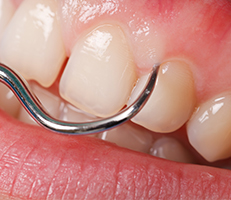Periodontal disease
Gum disease (or periodontal disease) is often a major cause of tooth loss in adults. It is believed that more than 70 percent of adults in the United States have some level of gum disease. Although genetics play a small role, dentists agree that gum disease is directly related to an individual’s personal dental hygiene. The disease begins with inflammation and infection of the tissues that provide tooth support, is usually painless and often goes undetected.
Gum disease is caused by toxins created when the bacteria in plaque builds up. In the early stage of gum disease (called gingivitis), gums become red and swollen and bleed easily.
Eventually the bones below the teeth become infected and begin to dissolve. Early detection can reverse the disease, and daily brushing and flossing can actually eliminate the problem.
However, in advanced cases, various treatment levels may be recommended to restore gums to a healthy state.
